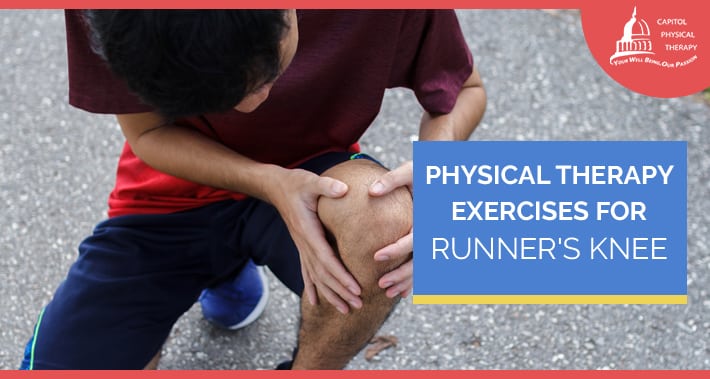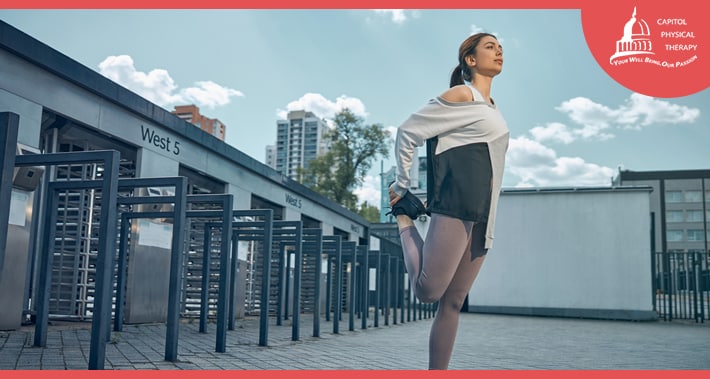
Whether you’re a serious or casual runner or you experience knee pain when sitting for long periods of time, you may be suffering from runner’s knee.
This is a painful condition that can stop anyone in their tracks.
Symptoms will usually dissipate after resting and icing the area, but preventative exercises reduce the recurrence of this condition and can help you get back to enjoying your sport.
At Capitol Physical Therapy, we offer physical therapy for running and sports injuries.
We also have a great catalogue of physical therapy articles for you to find out more about how your body works.
If you experience pain during running, a physical therapist can help by diagnosing the condition and teaching you how to take proper care of your body as you exercise.
Let’s examine the causes and symptoms of runner’s knee and look at some exercises to help you prevent injury.
What Is Runner’s Knee?
It’s important to take the time to understand how your knees work so that you can prevent common health issues from occurring.
Runner’s knee, also known as patellofemoral syndrome, chondromalcia patella, or anterior knee pain, is one of those common issues and usually affects runners, cyclists, and those performing activities involving jumping.
Contrary to popular belief, the condition is not directly caused by running.
You can also develop it from sitting for long periods of time with your knees bent.
The condition manifests itself in a dull pain around the patella, or kneecap, where it connects to the femur.
You may also experience rubbing, clicking, or grinding in the kneecap.
What Are The Symptoms Of Runner’s Knee?
The most common symptom of runner’s knee is pain in and around the kneecap when you are active.
Your kneecap may become tender to the touch.
You may experience a clicking or popping sound in your kneecap when you bend or straighten your leg.
These symptoms may be signs of a more serious condition, so be sure to see your physical therapist for proper diagnosis if the problem persists.
What Causes Runner’s Knee?
Runner’s knee could be the result of a physical defect of the knee.
It could also be due to an incorrect way of walking or running, with the feet rolling in while the thigh muscles put pressure on the kneecap.
Other causes are tightness in the tendons or weakness in the muscles, such as:
- Tight hamstrings
- Poor foot support
- Weak thigh muscles
- Tight Achilles tendons
- Tight knee joints
Excessive training or injury also causes runner’s knee.
Exercises To Prevent Ande Treat Runner’s Knee
There are many different exercises you can use to stabilize your knee.
Stabilizing your knee by strengthening your thigh and hip muscles is key to reducing your risk of developing runner’s knee.
If you’ve already developed runner’s knee, these same exercises can help you address your injury to better heal from it.
These exercises focus on stretching tendons and strengthening muscles that cause the issue.
For each exercise, you can target the injured leg, or stretch on both sides to build strength and flexibility.
1. Standing Quad Stretch
Your quads are the four large muscles at the front and top of your legs extending from your knee joint.
Standing upright and using the wall or a chair for balance, if needed, reach behind you to grab your right foot with your right hand.
Bring the heel up toward your glute muscle (your buttock), making sure not to overstretch and cause pain.
Keep your knee close to your body and push forward with the hip flexor.
Hold this position for 15 seconds or more, and then repeat on the left side.
Perform 2 to 3 sets on each leg.
If your quads are too tight, you can wrap a towel or band around your ankle, or lie on your stomach, reaching behind you to grab the ankle.

2. Standing Calf And Shin Stretch
Stand facing the wall, with your palms at eye level against the wall at a comfortable distance, elbows slightly bent.
Keeping the heel of your right leg on the floor, bend your left knee and move forward.
Turn your unbent leg slightly inward and lean into the wall until you feel the stretch in your calf.
Hold for 15 to 30 seconds, and then switch to the other leg, repeating each side three times.
3. Wall Slide
Stand with your back against the wall and your feet about 6 inches in front of you, hip distance apart.
Slowly move your back and hips down the wall until your knees are at a 45 degree angle.
Hold this position for 5 seconds and then stand back up.
Repeat this movement 10 to 15 times, performing 2 or 3 sets.
Remember, though, that this exercise should not aggravate your symptoms.
If it does, stop immediately and seek the advice of a physical therapist.
4. Standing Hip Stretch
To stretch your hip flexors, take a step back with one foot, splitting your stance so that one leg is slightly forward and the other one back.
Releasing your back heel from the ground, bend your back knee slightly, tilting your pelvis forward to feel the stretch in your hip flexor.
Make sure your spine remains in a neutral position and don’t arch or round your back.
Hold this for 10 seconds and then switch your legs and repeat.
5. IT Band Stretch
Your iliotibial band, or IT band, is a long piece of fascial tissue that runs along the outside of your legs, from your hip to your shin.
Stand up straight, crossing your right leg over your left.
Raise your right hand in the air and lean over to the left side until you feel a stretch.
Hold for up to 10 seconds, then switch sides and repeat.
Do this 2 or 3 times on each side.
Other Treatments For Runner’s Knee
If you are suffering from runner’s knee, the best course of action is to stop exercising immediately and rest the afflicted area until the pain subsides.
Here are some other treatments that may help to ease your symptoms:
- Cold packs on your affected knee
- Dry needling
- Elevating your leg
- Over the counter anti inflammatory medication for pain and to reduce inflammation
- Compression wrap on the knee
- Arch support in your shoes
- Use of foam rollers in the affected area
- Low impact activities such as cycling, swimming, yoga, or pilates
Book Your Appointment With Capitol Physical Therapy Today
If you’re recovering from runner’s knee, don’t be discouraged.
Running is still a great exercise with many health benefits.
Treatment for runner’s knee will be most successful with the help of a professional.
Your physical therapist will diagnose the issue and create a treatment plan based on your age, level of pain, history of injury, and overall health.
Remember, it’s important to stick to your full treatment plan in order to see the best possible results.
We offer physical therapy in DC and surrounding area, and can help you get started on a pain management treatment plan that will work for you.
With the support of a physical therapist, you can start running again.
Book your appointment with Capitol Physical Therapy today.
1331 H St NW #200,
Washington, DC 20005
- https://g.page/capitolptdc
9560 Pennsylvania Ave. # 202,
Upper Marlboro, MD 20772
- https://goo.gl/maps/zjL4NnnuThRhrcS86
Capitol Physical Therapy offers orthopedic and other pain related solutions, with our versitile team of physical therapists in Washington, DC